It was Thursday, August 7 and I picked up three "national" newspapers before boarding my flight to Tampa: The New York Times, USA Today and The Wall Street Journal. Disclaimer: I had read pieces from all three on my iPad either the night before, or that morning.
In all three cases, I rejoiced seeing the mix of stories, many of which I had not seen while reading on the phone and/or tablet. The obvious hard newsstories of the day did not appear in these front pages.
Amen, I said. I also thought that we are beginning to transition into doing print smartly, creating the ultimate lean back experience in print, but without ignoring those stories that we all should know about.
On this day the hard news of the day could be summarized as this:
--Israeli Premier Voices Regret for Civilian Casualties (in war with Gaza)
--Putin Bans Some Imports as Payback for Sanctions
--Bank of America to pay $16 Billion Fine
Let's see how the three national newspapers of the US handled these and other news on their front page.
Three front pages, three different approaches: The New York Times
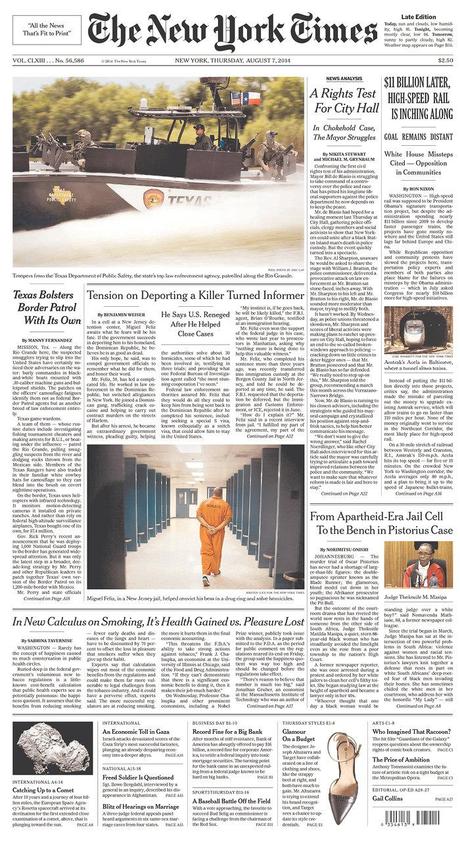
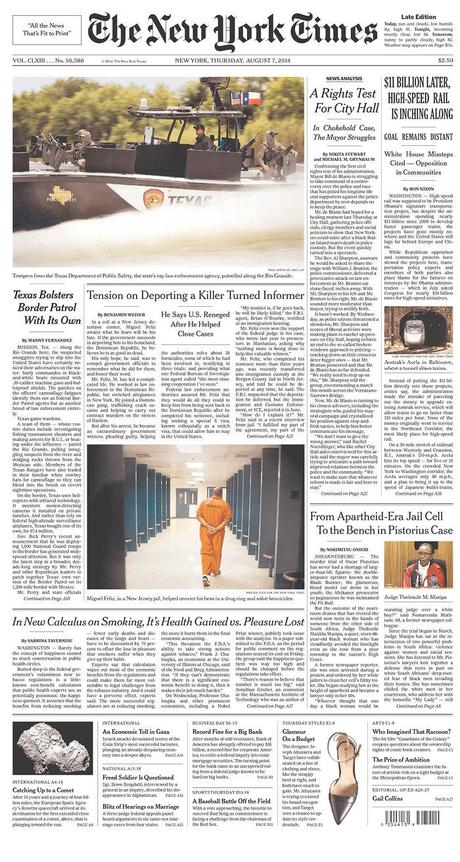
In my view, the Times did it best, not including any of these three stories as primary stories, and relegating them to "promo summaries" at the bottom of the page.
Instead, here are the stories played by the Times:
--$11 Billion Later, High Speed Rail is Inching Along
--News Analysis: A Rights Test for City Hall (In Chokehold Case, The Mayor Struggles)
--Texas Bolsters Border Patrol with its Own
--Tensions in Deporting a Killer Turned Informer
The Putin story appeared on Page A6 while the Gaza story appeared on A12, and the Bank of America story went to the front of the Business section.
All four of the main stories displayed on Page One had an element of surprise, or invited us to get into topics that were not the mainstay of mobile and/or TV news the past 24 hours. I found myself reading these stories. I stayed on Page One. That, after all, is what it's all about. It shows that print can still retain us if it surprises us and invites us to lean back.
By the way, I also like very much how the Times begins to integrate its new mobile digital products into print. In this edition, the item on Page 3--which is always premium space--was from the Times' most recent start up, The Upshot.
Three front pages, three different approaches: The Wall Street Journal
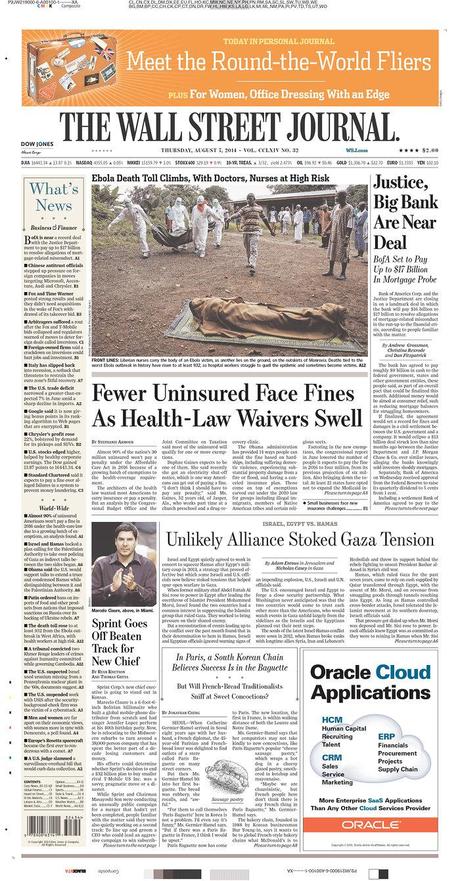
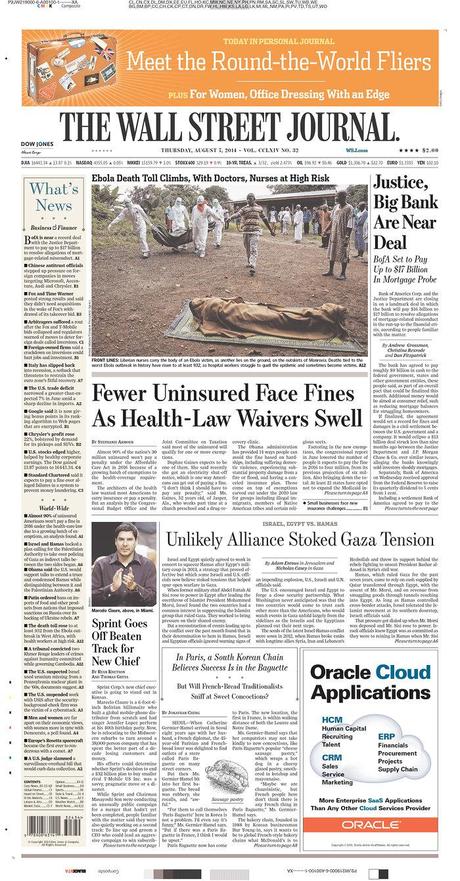
The Wall Street Journal was not as daring as The New York Times in stripping its front page of all the hard news of the day.
The Bank of America story made it to the right hand side lead position, but only with a one column headline.
A photo story at the top of the page reminded readers of the dangers of the Ebola outbreak (something that we have been saturated with via mobile and television). In my view, this did not belong here, and it was a generous amount of space devoted to a tired image. Just like we must surprise with stories, we must surprise with photos and/or graphics.
The other headlines on the page all covered more invisible type stories:
--Fewer Uninsured Face Fines As Health-Law Waivers Swell
And, then, the iconic A-Hed story: the grandfather of all invisible stories:
--In Paris, a South Korean Chain Believes Success is in the Baguette
Three front pages, three different approaches: USAToday
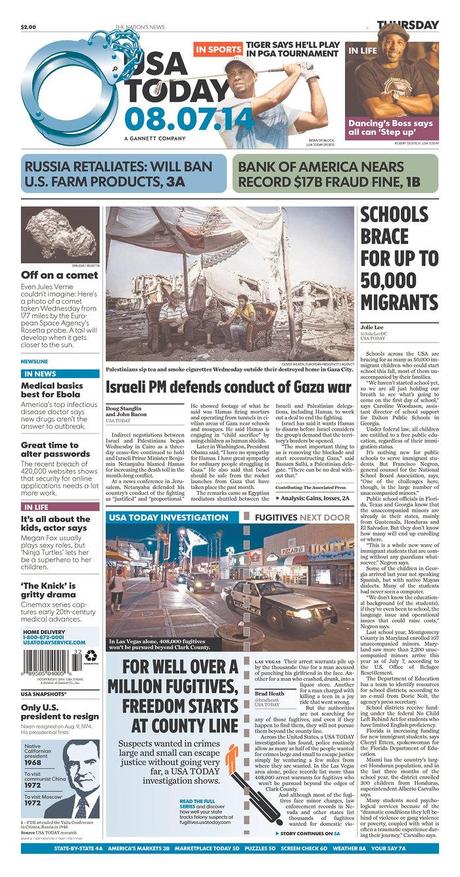
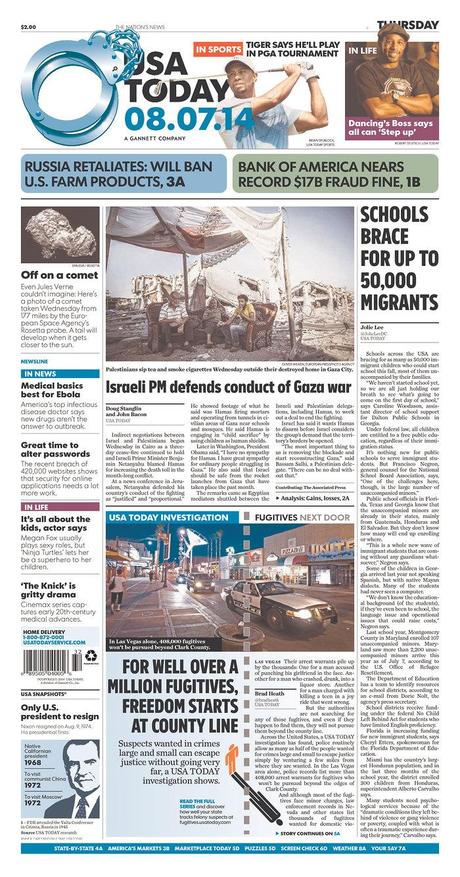
It is a bit ironic that USA Today, the paper that gave us one innovation after another when it was launched in 1982 (think the biggest and most colorful weather map ever, all those information nuggets to allow us to get the story faster, the NO editorial opinion page), was probably the most conservative of all three newspapers studied here in terms of how it played stories on Page One.
First, two of the most obvious stories, Bank of America and Putin, were promoted on colorful boxes right under the logo.
The top visual promo was Tiger Woods and the story about his playing in the PGA Tournament (something that we had heard repeatedly hours before).
However, two more invisible stories did make it prominently on Page One:
--Schools brace for up to 50000 migrants
--USA Investigation: For Well Over a Million Fugitives, Freedom Starts at County Line
This is progress
These three newspapers--The Times, WSJ and USA Today-- are usually role models for smaller local and regional dailies not only in the US, but globally.
The fact that they are beginning to rethink content of their print front page, and to do it smartly, emphasizing surprises, the off the beaten path story and creating a more contemplative mood, is all progress.
Of related interest
Are newspapers doomed? It depends.
http://newsosaur.blogspot.com/?spref=tw
Highlight:
The future of newspapers – or, more precisely, local news ventures that may or may not involve putting ink to paper – will depend on whether the people running them are up to the considerable challenge of creatively disrupting their businesses before an ever-growing phalanx of digital competitors destroy what’s left of the still-enviable commercial might and journalistic value of their enterprises.

